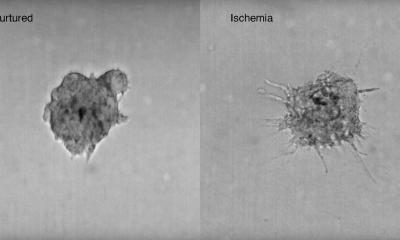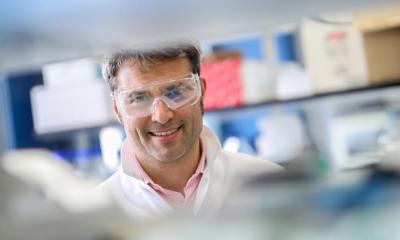Gene variation promotes uncontrolled cell division
Mom’s eyes and dad’s tumor? Cancer is due to genetic defects, some of which can be hereditary. The gene variant rs351855, for example, occurs in one in two cancer patients. A team headed by Axel Ullrich from the Max Planck Institute of Biochemistry in Martinsried identified the gene variant a decade ago. Now, they succeeded for the first time in showing that the variation exposes an otherwise hidden binding site on the FGFR4 receptor. There, growth factor STAT3, which promotes cancer, binds to the exposed site. The STAT3 signaling cascade can be efficiently blocked. This could provide a promising therapeutic approach for many cancer patients.

A human is a human: we are all 99.9% genetically identical. However, the remaining 0.1% accounts for the unique characteristics of each individual, whether he or she is tall or short, allergic or susceptible to autoimmune diseases. Those three million or so of the 3.2 billion genetic building blocks in our genome may contain the answer to the question of whether we will develop cancer in the course of our lives.
Cancer is a genetic disease, i.e. it is due to defects in the genetic material DNA. Such harmful mutations can be acquired in the course of life, as a result of exposure of skin cells to intense sunlight, for example, or toxins from cigarette smoke in the lungs. However, some defects are passed on as inheritable genetic variants to offspring, who then carry those defects in every cell of their body.
One such cancer-associated germline mutation is called rs351855. It was discovered in patients with breast cancer by a team headed by Axel Ullrich, Leader of the Molecular Biology Research Group, a decade ago. This particular genetic variant can support the growth of malignant tumors in bones, the colon, the prostate, the skin, the lungs and the head and neck, as well as to the growth of soft-tissue sarcomas and non-Hodgkin’s lymphoma.
About half of all cancer patients carry this gene variation. It is associated with a poor prognosis. The germline mutation rs351855 accounts for aggressive and rapidly growing tumors that are resistant to treatment. An effective treatment needs to be tailored to match the mutation and its biological effects.
Subsequent studies have shown that rs351855 results in the replacement of a single protein building unit in a receptor for growth factors. Fibroblast growth factor receptor 4 (FGFR4) is then expressed in the form of the FGFR4 p.Arg388 variant. Scientists around the world are trying to find out why only this particular genetic variant, out of more than 400 known ones of FGFR4, has such a high impact. Moreover, the genetic mutation occurs very frequently, around one-third of the population carry it in the genome. It is not known, whether this variation itself increases the general risk of cancer.
Ullrich and his associates have now demonstrated for the first time that the defect results in a previously unknown biological function in living cells. They showed in an animal model that the defect exposes a normally hidden binding site on the receptor molecule near the inner cell membrane. Growth factor STAT3, which promotes cell division and tumor growth, is then able to dock to the receptor.
Cells do not usually proliferate out of control, because they only divide in response to a signal that they receive from the outside. This molecular message is picked up by receptors such as FGFR4 and is then relayed through the cell membrane into the interior of the cell, thus setting in motion a cascade of molecular interactions with molecules such as STAT3 that culminates in the cell nucleus, where genes are activated that direct the actual process of cell division.
This hierarchical process is often undermined in cancer. The cells divide without an external command. That is the case, for example, when STAT3 is activated by abnormal binding to the defective receptor. Such interaction of STAT3 close to the inner cell membrane was previously unknown and unexpected. “I wasn’t really convinced until various experimental approaches produced matching results,” says Vijay K. Ulaganathan, lead author of the study.
The scientists have also shown that the growth of cells carrying this gene variant can be inhibited by blocking STAT3. “For the first time, there may be very good prospects of an effective treatment option for cancer patients with this respective germline mutation,” says Ullrich. Others may also be affected: Other germline mutations also exist that recruit STAT3 to the inner cell membrane and may also lead to cancer.
The work is an important step towards personalized medicine, which takes into account the individual genetic makeup of cancer patients. “As we have shown here, we need to focus on germline mutations as well,” says Ullrich. “Research should not be limited to environmentally-related genetic defects.” Ullrich is a pioneer in personalized medicine. Among other things, he developed together with colleagues Herceptin, a drug that is tailor-made for treating breast cancer associated with specific mutations.
Original publication:
V. K. Ulaganathan, B. Sperl, U. R. Rapp, Axel Ullrich: Germline variant FGFR4 p.G388R exposes membrane-proximal STAT3 binding site, Nature, December 2015, DOI: 10.1038/nature16449
Source: Max-Planck-Institut of Biochemistry
06.01.2016











